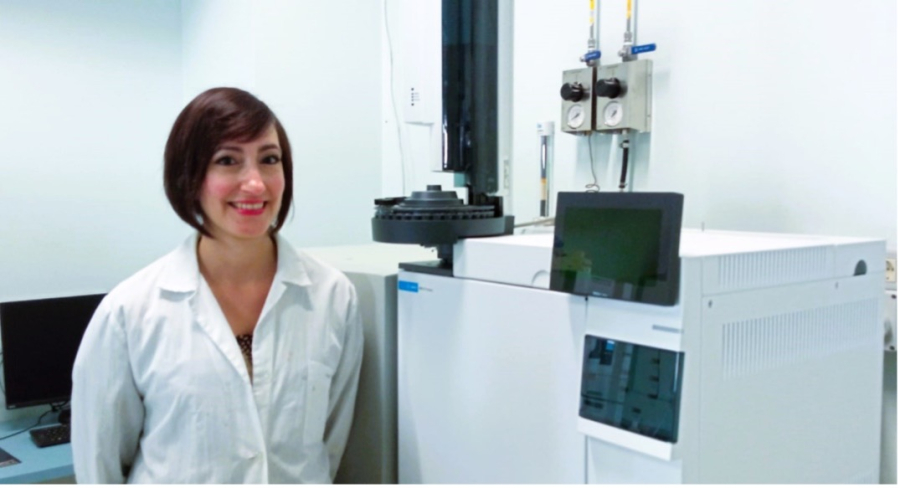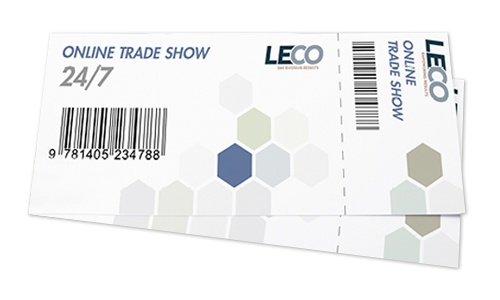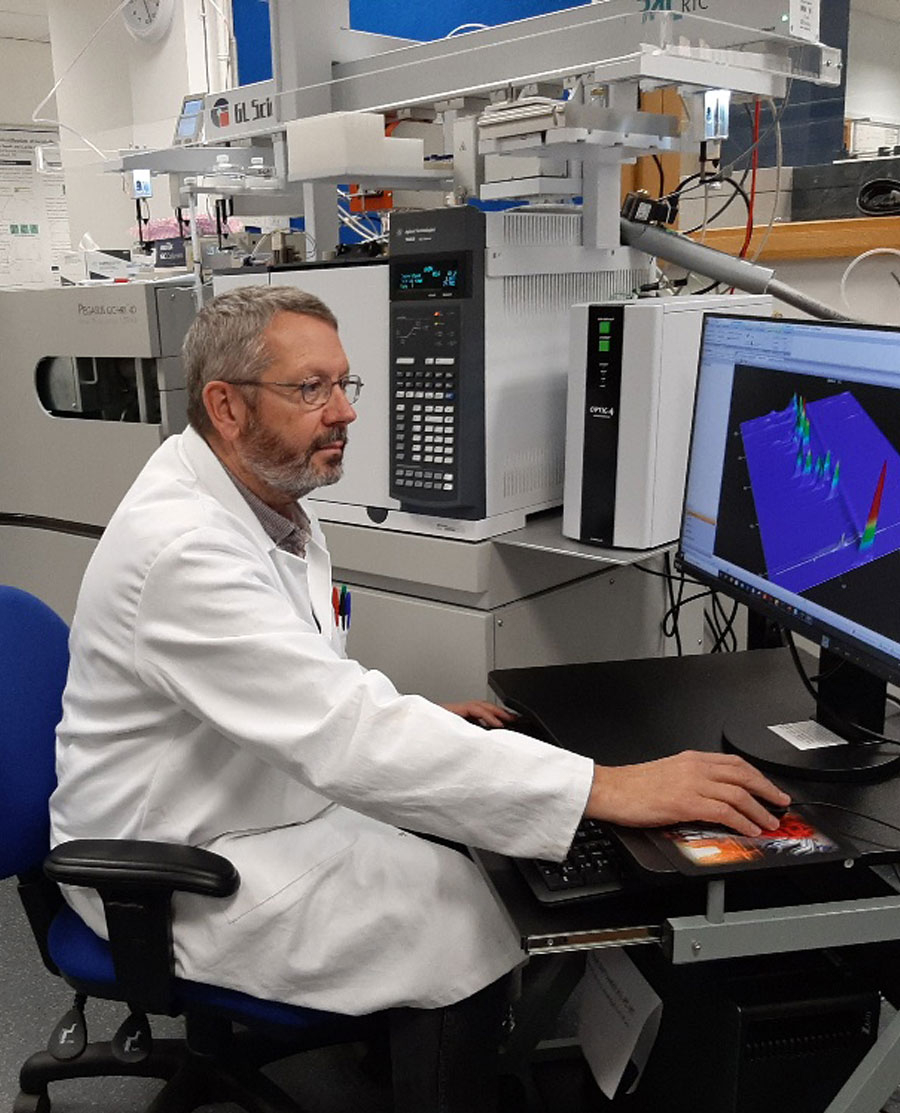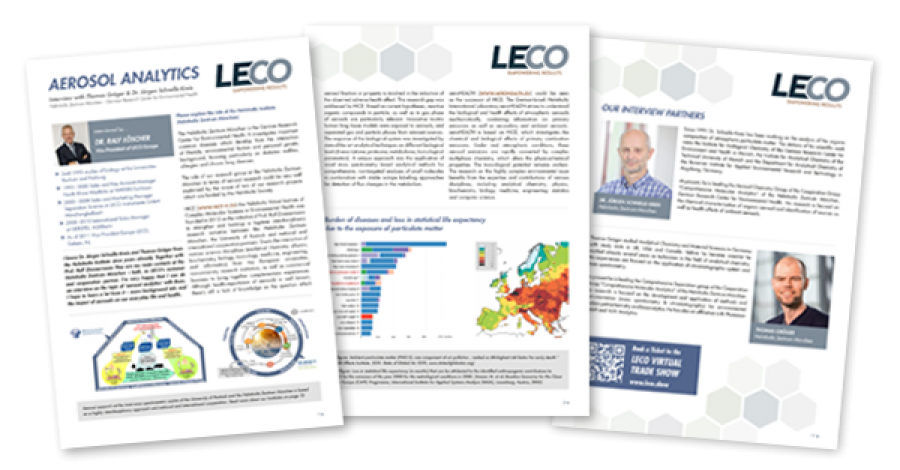
 LECO
Empowering Results
LECO
Empowering Results
Afficher les éléments par tag : Environnement
We started using the LECO PEGASUS® BT GC-TOF mainly for target analysis of aliphatic hydrocarbons on environmental matrices; over time we had the need to develop a method for the qualitative characterization of hop leaves samples for a research project, the ChromaTOF® deconvolution software allowed the identification of several compounds, in particular different terpenes. The Pegasus BT GC-TOF thus proved to be an excellent system, easy to use, with high sensitivity and reproducibility, able to perform both non target and target analysis.
Your TOC analysis has never been easier with LECO’s solutions
Carbon is an essential building block of life on our planet. The amount of Carbon present is an important factor in soils and agriculture samples.
The determination of TOC in solids has recently become ever more important, not just for evaluating wastes but TOC content measurements are also an important aspect of assessing soils.
The Carbon present in soil organic matter is referred to as organic Carbon. Soil organic Carbon is a vital component of productive agriculture. In addition sequestration of Carbon in agricultural soils has been recognised as a tool to mitigate climate change.
LECO provides innovative and timesaving analytical instrumentation for the analysis of organic Carbon content.
Specific Advantages Including
- Market leading analytical performance
- Simplified sample preparation
- Robust & reliable instrumentation
- Unsurpassed instrument flexibility
- Adhering to all the current standards, such as ISO 10694, BS EN 17505 and EN 15936
Instrument Portfolio for TOC Analysis
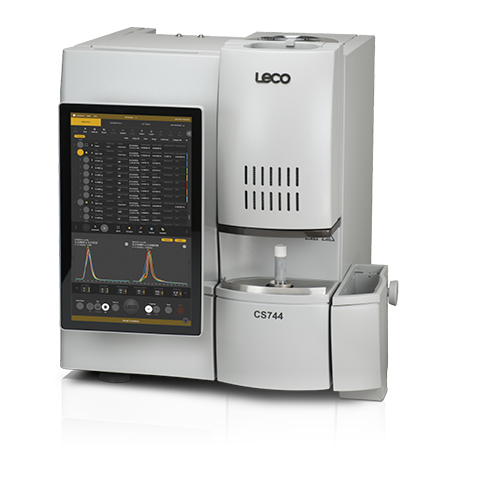
CS744 // Carbon analysis by combustion
Redefine the way you determine carbon in soils and plant tissues with our 744 series. Using extensive customer feedback and innovative engineering, the 744 takes advantage of our immersive CORNERSTONE® brand software platform and a number of features, ...
... such as an improved IR cell design and available automation, come together to increase usability, lab productivity, and lower your cost-per-analysis.

RC612 // Multi-Phase Carbon And Water Determination
Get fast, reliable carbon and water determination with our RC612. The RC612 is a resistance furnace multiphase carbon and moisture determinator which quantifies the carbon and moisture present in soils and plant tissues and illustrates the source of several types of carbon.
The RC612 features a state-of-the-art furnace control system, which allows the temperature of the furnace to be stepped and ramped from near ambient to 1,100 °C, in either oxidative or reductive carrier gas. The RC612 utilizes an afterburner furnace that ensures complete combustion of volatile species released at lower primary furnace temperatures.
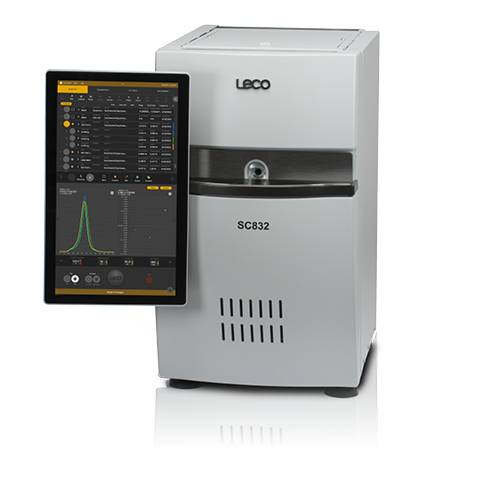
SC832 // Sulfur And Carbon Analysis
LECO’s 832 series of Elemental Determinators are specifically designed to perform carbon and sulfur analysis of soil, plant tissue and other organic and some inorganic materials. The 832 series is a valuable resource for any laboratory needing fast and accurate analysis.
Request SC832
Methods of TOC analysis include
1. Acid Digestion Method
The most common method for determining TOC is the acid digestion method. By acid treating a sample, usually with hydrochloric acid, which is strong enough to react with inorganic carbonates but does not react much with organic Carbon, the inorganic carbonate species within the sample will effervesce as Carbon dioxide. The acid-treated sample and a non-acid-treated sample can both be analyzed using either the LECO C744 series or LECO C832 series for Carbon content. The untreated sample would indicate the total carbon content, while the acid-treated sample’s Carbon content would be the remaining organic Carbon content. The difference between the two samples would be the total inorganic Carbon (TIC) content.
2. Temperature Dependent Method
Another Carbon determination method is temperature dependent. With the temperature dependent method, samples do not need to be pretreated. Organic Carbon combusts to CO2 between 150 °C and 450 °C, while inorganic species combust below 1,000 °C. The RC612 resistance furnace multiphase Carbon and moisture determinator performs this analysis by using a two-step temperature ramping at 450 °C and 1,000 °C without any acid pretreatment of the samples. The CO2 gases are swept through to an NDIR at 450 °C and again at 1,000 °C to determine the TOC and TIC in the sample.
For a more comprehensive exploration of these two methods, as well as an in-depth comparison of LECO instrumentation, please contact us:
On-demand Presentation // Watch the recorded Webinar
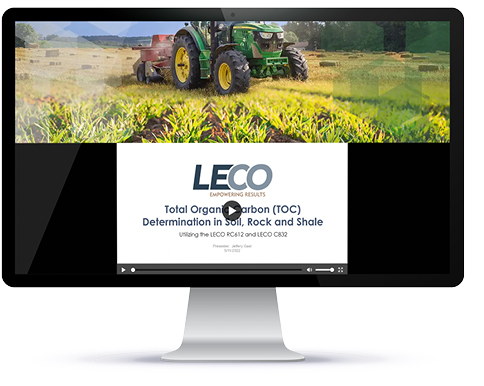
Détermination du carbone organique total (COT) dans le sol à l'aide d'un traitement à l'acide et d'une différenciation de la température
Presented by Jeffery Gast
The presentation will outline TOC determination in soil using two different approaches. First, we will explore the use of acid treatment of the soil to remove carbonates followed by analysis using conventional combustion techniques. Next, we will explore using a ramped furnace temperature approach to differentiate organic and inorganic carbon species. TOC results from both approaches will be presented.
Publication Library
Dive deeper into TOC analysis
Enhance your knowledge with our selection of publications. Discover techniques, comparisons, and applications in our downloadable resources, gaining valuable insights and enriching your understanding of Total Organic Carbon (TOC) analysis.
Click to download app note
- "Temperature-Dependent Determination of Total Organic Carbon (TOC) in Soil, Rock, and Shale" using RC612
- "Determination of Total Organic Carbon in Soil, Rock, and Shale by Acid Digestion and Combustion" using 832 Series
Click to download poster

If you want to learn more about our products and solutions for TOC analysis, book a free ticket to our Virtual Trade Show, or schedule an online demo for a deeper insight in our instruments.
Your TOC analysis has never been easier with LECO’s solutions
Carbon is an essential building block of life on our planet. The amount of Carbon present is an important factor in soils and agriculture samples.
The determination of TOC in solids has recently become ever more important, not just for evaluating wastes but TOC content measurements are also an important aspect of assessing soils.
The Carbon present in soil organic matter is referred to as organic Carbon. Soil organic Carbon is a vital component of productive agriculture. In addition sequestration of Carbon in agricultural soils has been recognised as a tool to mitigate climate change.
LECO provides innovative and timesaving analytical instrumentation for the analysis of organic Carbon content.
Specific Advantages Including
- Market leading analytical performance
- Simplified sample preparation
- Robust & reliable instrumentation
- Unsurpassed instrument flexibility
- Adhering to all the current standards, such as ISO 10694, BS EN 17505 and EN 15936
Instrument Portfolio for TOC Analysis

CS744 // Carbon analysis by combustion
Redefine the way you determine carbon in soils and plant tissues with our 744 series. Using extensive customer feedback and innovative engineering, the 744 takes advantage of our immersive CORNERSTONE® brand software platform and a number of features, ...
... such as an improved IR cell design and available automation, come together to increase usability, lab productivity, and lower your cost-per-analysis.

RC612 // Multi-Phase Carbon And Water Determination
Get fast, reliable carbon and water determination with our RC612. The RC612 is a resistance furnace multiphase carbon and moisture determinator which quantifies the carbon and moisture present in soils and plant tissues and illustrates the source of several types of carbon.
The RC612 features a state-of-the-art furnace control system, which allows the temperature of the furnace to be stepped and ramped from near ambient to 1,100 °C, in either oxidative or reductive carrier gas. The RC612 utilizes an afterburner furnace that ensures complete combustion of volatile species released at lower primary furnace temperatures.

SC832 // Sulfur And Carbon Analysis
LECO’s 832 series of Elemental Determinators are specifically designed to perform carbon and sulfur analysis of soil, plant tissue and other organic and some inorganic materials. The 832 series is a valuable resource for any laboratory needing fast and accurate analysis.
Request SC832
Methods of TOC analysis include
1. Acid Digestion Method
The most common method for determining TOC is the acid digestion method. By acid treating a sample, usually with hydrochloric acid, which is strong enough to react with inorganic carbonates but does not react much with organic Carbon, the inorganic carbonate species within the sample will effervesce as Carbon dioxide. The acid-treated sample and a non-acid-treated sample can both be analyzed using either the LECO C744 series or LECO C832 series for Carbon content. The untreated sample would indicate the total carbon content, while the acid-treated sample’s Carbon content would be the remaining organic Carbon content. The difference between the two samples would be the total inorganic Carbon (TIC) content.
2. Temperature Dependent Method
Another Carbon determination method is temperature dependent. With the temperature dependent method, samples do not need to be pretreated. Organic Carbon combusts to CO2 between 150 °C and 450 °C, while inorganic species combust below 1,000 °C. The RC612 resistance furnace multiphase Carbon and moisture determinator performs this analysis by using a two-step temperature ramping at 450 °C and 1,000 °C without any acid pretreatment of the samples. The CO2 gases are swept through to an NDIR at 450 °C and again at 1,000 °C to determine the TOC and TIC in the sample.
For a more comprehensive exploration of these two methods, as well as an in-depth comparison of LECO instrumentation, please contact us:
On-demand Presentation // Watch the recorded Webinar

Détermination du carbone organique total (COT) dans le sol à l'aide d'un traitement à l'acide et d'une différenciation de la température
Presented by Jeffery Gast
The presentation will outline TOC determination in soil using two different approaches. First, we will explore the use of acid treatment of the soil to remove carbonates followed by analysis using conventional combustion techniques. Next, we will explore using a ramped furnace temperature approach to differentiate organic and inorganic carbon species. TOC results from both approaches will be presented.
Publication Library
Dive deeper into TOC analysis
Enhance your knowledge with our selection of publications. Discover techniques, comparisons, and applications in our downloadable resources, enriching your understanding of Total Organic Carbon (TOC) analysis. Gain valuable insights by filling out our form to access the download files.
Download App Note
- "Temperature-Dependent Determination of Total Organic Carbon (TOC) in Soil, Rock, and Shale" using RC612
- "Determination of Total Organic Carbon in Soil, Rock, and Shale by Acid Digestion and Combustion" using 832 Series
Download Poster

If you want to learn more about our products and solutions for TOC analysis, book a free ticket to our Virtual Trade Show, or schedule an online demo for a deeper insight in our instruments.
University of Southampton
"In 2019 EPSRC funded our vision for a regional Centre of Excellence (CoE) in 2 dimensional gas chromatography and mass spectrometry. This Regional CoE, initially embracing the Universities of Bath, Portsmouth, Southampton, and Swansea, will significantly drive discovery, characterisation and quantification of new modalities, delivering a step change in capability for detection and identification of new species that cannot be separated and determined by 1D GC alone.
LECO’s Pegasus HRT 4D GC×GC-TOFMS and the benchtop BT4D GC×GC-TOFMS, both with extensive automated sample handling capability were delivered in late 2019 and early 2020. Installation of these state-of-the-art instruments was complicated by Covid-19 and lockdown 1.0. With such complex instrumentation, and application areas, effective training was key; here LECO took the initiative and provided both bespoke local and on-demand online training.
The level of service support and close collaborative relationship with LECO (applications team and account manager) has been first rate. Both systems can now be operated remotely, enabling high level users from across the South West region to access the instrumentation and allow many complex questions to be probed. Our work covers a vast array of application, e.g. petrochemical, environmental and metabolomics. The data sets are rich and complex, yet simplified by a user friendly software interface. Compared to 1D-GC, the 4D systems provide an astonishing number of additional analyte identifications, giving us deeper insight and understanding of the samples. Combining LECO’s high resolution mass spectrometry with comprehensive gas chromatography, multiple sample handling options such as SPME, Pyrolysis and TD along with full automation has created a world class laboratory of which we are all very proud."
Le Dr Ralf Löscher, vice-président de LECO Europe, s'entretient avec Thomas Gröger et le Dr Jürgen Schnelle-Kreis du Helmholtz Zentrum München, le Centre de recherche allemand pour la santé environnementale, pour en savoir plus sur l'impact des aérosols sur notre vie quotidienne et notre santé et en tirer profit pour obtenir quelques informations générales sur leur travail.

La récente série d’eSeminar sur SepScience.com, couvrant les solutions de LECO pour l’analyse des aliments et de l’environnement, est désormais disponible en version à la demande. Les discussions abordent des sujets autour du domaine difficile de l’analyse ALIMENTAIRE et de l’analyse ENVIRONNEMENTALE des milliers de produits chimiques présents dans nos réserves en air, en terre et en eau.
Ou visitez notre nouveau salon virtuel
Veuillez vous joindre à nous pour deux prochains eSéminaires sur SepScience.com. Nous présentons comment les technologies de pointe LECO GC-TOF-MS et GC×GC-TOF-MS peuvent considérablement améliorer vos applications pour l’analyse des aliments (9 juin) et l’environnement (11 juin).
Cliquez pour vous inscrire maintenant !
Aujourd’hui, le 20 mai, c’est la Journée mondiale des abeilles mellifères. L’abeille est une espèce pollinisatrice importante qui contribue à environ 15 milliards de dollars par an à l’économie américaine grâce à la pollinisation des cultures et 690 millions de livres sterling à l’économie britannique. Les abeilles sont également d’importants pollinisateurs sauvages et jouent un rôle clé dans le maintien de la biodiversité et des services écosystémiques dans de nombreux écosystèmes.
Les feux d’artifice sont un incontournable des célébrations du jour de l’indépendance américaine. On estime que 16 000 feux d’artifice sont organisés aux États-Unis chaque année, et que les consommateurs américains dépensent plus d’un milliard de dollars en feux d’artifice pour marquer les fêtes ! Au-delà des explosions et des effets lumineux, comment ces feux d’artifice affectent-ils l’environnement où ils sont utilisés ? Le siège social mondial de LECO est situé à Saint Joseph, dans le Michigan, une station balnéaire au bord du lac Michigan où les feux d’artifice sont la toile de fond de la célébration du 4 juillet. L’été dernier, notre laboratoire d’applications a pensé qu’il serait bénéfique et intéressant de tester l’eau entourant le site de lancement des feux d’artifice, pour détecter la présence d’impacts environnementaux à court terme. L’afflux de touristes sur les plages du lac Michigan pendant les vacances participe au déversement de produits chimiques et cosmétiques (crèmes solaires et répulsifs anti-insectes) dans l’eau. L’évaluation de ces contaminants potentiels pendant les vacances du 4 juillet était l’objectif de cette étude.
L’analyse a été réalisée en prélevant des échantillons d’eau à trois endroits différents le long du rivage : sur le site de lancement des feux d’artifice au large de la jetée, et sur deux plages locales à proximité du site de lancement. Ils ont été prélevés le 2 juillet et le 4 juillet (une heure après les feux d’artifice) pour fournir une mesure précise. Le système 4D du Pegasus HRT+ de LECO a été utilisé pour analyser les échantillons d’eau ; celui-ci offre une chromatographie gazeuse bidimensionnelle complète couplée à une spectrométrie de masse à temps de vol haute résolution (GC×GC-HRTOFMS). Le GC×GC-HRTOFMS s’est avéré être un puissant outil d’exploration, car il a fourni une analyse complète et non ciblée des échantillons d’eau, avant et après les feux d’artifice, démontrant clairement les différences chimiques entre les deux. Le GC×GC-HRTOFMS a également été en mesure d’identifier les contributions à la pollution environnementale résultant de ces spectacles pyrotechniques et de l’augmentation de la fréquentation humaine à proximité des sites d’échantillonnage de l’eau.
En quoi la qualité de l’eau du lac Michigan a-t-elle été affectée en raison de l’augmentation de la fréquentation touristique et des feux d’artifice ? Les résultats pourraient vous surprendre…
Frank Dorman, professeur agrégé de biochimie et de biologie moléculaire à la Penn State University, a parlé lors de notre petit-déjeuner-conférence de l’ASMS de son expérience avec notre Pegasus BT 4D GC×GC-TOFMS de paillasse pour analyser la contamination environnementale dans la rivière Susquehanna.
